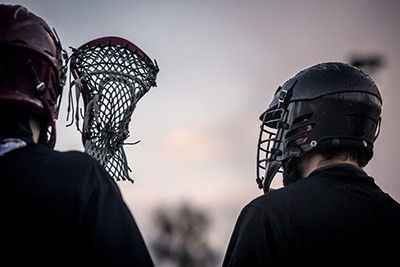Are you considering playing college lacrosse? Do not worry, we are here to help! We have gathered insight from the best college lacrosse experts to understand what it takes to be successful at this elite level.
This blog post will provide an overview of what collegiate lacrosse requires and how players can get recruited for their desired schools.
More...
Take Away Key Points:
College Lacrosse: A Championship Game!
If you want to know more about how collegiate players play lacrosse, read the guide below and find the critical points to consider.
1. The history of the college lacrosse
College Lacrosse has a long and storied history that traces its roots as far back as the mid-1800s. It is said to be the oldest intercollegiate sport in America, created sometime around 1877.
The first collegiate lacrosse competition occurred between New York University and Manhattan College. In 1882, games were formalized into seven rules, and the Intercollegiate Lacrosse Association - ILA was established.
The first competing colleges included Princeton and Harvard, but Colombia, New York, and other universities also joined the championships. Throughout its history, college lacrosse continued to grow, disregarding war efforts and other pauses in play.
Since 1971 great leaps have been made in college lacrosse with the implementation of full-time coaching and improvements in both men's and women's programs. The NCAA began sponsoring men's lacrosse and holding championships and tournaments for D I schools.
Today nearly 150 universities across the United States offer NCAA Division I lacrosse, while over 200 more offer D III programs. College lacrosse has indeed come a long way since its humble beginnings!

2. College-played lacrosse vs. men's lacrosse
College lacrosse is organized and played by NCAA rules. It is developed to fit into the student-athlete program and requires both physical conditioning and accurate passing skills due to its heightened level of competitiveness over field lacrosse.
The main difference between college and men's games lies in the rules. The NCAA defines regulations for men's college game versions, such as the general size of the playing field, the number of players on each team, shot clock enforcement, and equipment requirements.
In contrast, traditional men's lacrosse differs from a college version because it may be commonly referred to as outdoor or box lacrosse. It has more teammates per team than NCAA–regulated college lacrosse, fewer restrictions on contact when checking opponents' sticks, greater emphasis on taking jumps to catch passes or shots from ground level, and different rake length limits for goalies.
3. Participation & scholarships
College lacrosse is a fast-paced and dynamic sport that offers considerable rewards to student-athletes, both on and off the field. As a result, scholarship opportunities are growing significantly, with impressive packages of monetary incentives being made available to top lacrosse players.
Additionally, intramural and clubs allow players to compete against different levels of competition, encouraging growth and honing skills. Finally, high school students looking to join college-level games can take advantage of intensive coaching and training camps explicitly designed to help younger athletes take their game to the next level.
By participating in championships, viewing competitions, and meeting experienced players, high schoolers have the chance to see professional lacrosse up close. High schoolers can notice professional skills and talent, watch them on the field and focus on improving their playing time. Thus, they pave the way for a smooth transition into collegiate-level play later on.
Ultimately, college play offers excellent potential for personal development while allowing athletes to become competitive members of their university athletics team.
4. NCAA lacrosse: Professional championships
The NCAA is the main governing body of 397 of the wholesome 431 men's college lacrosse clubs offered at four-year institutions. The NCAA is responsible for lacrosse championships in all three divisions in men's and women's lacrosse. There are 525 women's lacrosse programs in the NCAA.
The NAIA governs the remaining 33 men's lacrosse clubs. Student-athletes searching for a collegiate lacrosse career at junior colleges can choose among 28 lacrosse programs. The wide variety of these groups is located in the Northeast and Mid-Atlantic.

a. Division I men's lacrosse by the NCAA
The National Collegiate Athletic Association - NCAA D I Men's Lacrosse consists of a total of 74 teams from renowned universities throughout the United States and Canada. They are organized into eleven conferences.
By far, the United States dominates the sport with 63 teams situated from California to Massachusetts. The main purpose of creating such a division was to acknowledge lacrosse as an official sport in college athletics, allowing students equal access to opportunities and experiences.
Moreover, most players represent certain states and/or regions as many tournaments are composed of local squads. These exciting journeys are embraced by student-athletes worldwide who love competing against rivals while exhibiting tremendous sportsmanship.
This lacrosse division is highly competitive. It is located in the Northeast region and Mid-Atlantic and recruits the top 5% of men's lacrosse players each year.
Recruited athletes at this level achieve a high point of athletic and academic success. Therefore, they can be rewarded for both with a scholarship. However, an athletic scholarship might be hard to obtain even at this lacrosse level.
Students looking to compete at the D I level should start by researching the best D I NCAA men's lacrosse colleges. Some include Long Island, Manhattan College, Ohio State, Boston, Harvard University, New Jersey, SUNNY Stony Brook University, etc.
b. Division II men's lacrosse by the NCAA
The Division II Men's Lacrosse by NCAA season is underway and shaping to be an exciting year. Featuring 75 teams across the country, Division II lacrosse is a growing collegiate sport that strives to develop talented players while providing a fun way to compete in friendly rivalry.
The primary purpose of this division is to foster the healthy development of players and individuals at a collegiate level, allowing them to take their skill sets beyond high school.
Players are exposed to competitive tournaments regulated by regional associations, motivating athletes and preparing them for higher-level competition. With the talent pool increasing each year, D II Men's Lacrosse by NCAA has quickly become one of the most exciting college sports around.
The D II of the NCAA lacrosse is divided into eight conferences, from Northeast to Southeast. However, these NCAA programs are often overlooked. This is because the programs lack multiple opportunities to play in D III and the notoriety of D I run by the NCAA.
Some of the best colleges for the NCAA II program include the University of Tampa, Lynn, Quincy, University of Indianapolis, etc.
c. Division III men's lacrosse by the NCAA
The D III men's lacrosse, run by the NCAA, is an athletic division that consists of 247 teams across the United States. They are divided into 24 conferences and more than twenty program types.
Built upon a model of community-based athletics, these players are mostly located in colleges and universities but may also include high schools, club teams, and recreational leagues.
The primary purpose of D III lacrosse is to provide student-athletes with the opportunity to hone their skills and pursue healthy team experiences during their college years.
At the championships each year, athletes compete for the title of National Champions—a level of honor achieved by few. Players in this division may also engage in tournaments and events throughout the regular season, which builds morale and further develops a strategy for players and coaches. In addition, players have fun while playing in an appropriate educational setting.
This remains an essential factor throughout their season. While Division I and II usually garner more media attention than Division III athletics, this does not take away from the fact that Division III is still an incredibly popular sport for student-athletes pursuing their college dreams.
Rather than athletic scholarships, D III schools provide student-athletes with various types of financial help, including grants, academic scholarships, and other need-based financial aid. These final help types are mostly based on the athlete's test scores, GPA, test, and similar requirements determined by each school.
Some of the best universities of the D III NCAA program include Washington & Lee, Massachusetts Institute of Technology, Tufts, Williams College, Johns Hopkins University, Maryland, etc.
5. NCAA Women's Lacrosse
Women's college lacrosse differs from men's in terms of equipment and rules. The NCAA is responsible for championships for all three divisions. The NCAA currently has 524 women's projects.
Women's collegiate games were governed by the Women's Lacrosse Association. The association later joined the Association for Intercollegiate Athletics for Women (AIAW) to determine an annual champion.
The AIAW and USWLA held championships between 1978 and 1982 before being dominated by the NCAA. The NCAA also sponsored a D III championship in 1985 and a D II championship in 2001.
a. Division I women's play by the NCAA
NCAA D I women's lacrosse is the top collegiate competition for players. It is comprised of over 120 teams from around North America. They are divided into fifteen conferences with twelve projects. Each college strives to develop talented players and provide them with an opportunity to play at the highest level.
The main purpose of NCAA D I, as with all levels of competitive lacrosse, is to exhibit skillful, spirited athletic competition. Each team takes the field in a battle for the coveted national championship title that is decided in a single-elimination tournament, one match at a time. With expected energy, speed, and productive players on display, the D I girls continue to be a thrilling game to watch.
Some of the best universities include America, Boston, Campbell, Cornell, Duke University, etc.
b. Division II women's play by the NCAA
D II by the NCAA is a competitive sport with 114 clubs throughout the United States. It was established in 2001 to provide an opportunity for students to participate in collegiate sports at a competitive level. Currently, the D II has ten conferences along with independent projects.
Games consist of two halves, and each team consists of twelve players, including attack, mid-fielders, defense, and goalies. Games generally follow the NCAA regulations according to the current ruleset from IMLCA, which sets standards for both women's and men's leagues.
The NCAA Championships are held every year in May. In addition, regional tournaments are held each season involving top clubs from national conferences, culminating in eight to 16 clubs vying for their chance to win the national championship.
Some of the best universities include Barton, Colorado, American International College, Dominican University, New York, etc.
c. Division III women's play by the NCAA
This NCAA program consists of 291 teams across the entire U.S. The primary purpose is to provide an opportunity for high school graduates to complete their academic and athletic careers. They can teach and learn in an environment that emphasizes learning, growth, sportsmanship, and fairness.
Universities do not offer any athletic scholarship types, but schools will often cover tuition and other expenses through other forms of financial aid. This allows students to focus on academics, enjoy competitive athletics, and work toward a degree without being tied down by commitment to one particular sport or team.
The goal of this division is to build life-long relationships between the students, coaches, and administrators alike through respect for one another and the game they all love.
Some of the best universities include Colby College, MIT, Williams, Tufts College, etc.
6. NAIA Lacrosse
NAIA is the largest competitive post-secondary lacrosse organization in the U.S. Composed of 39 college institutions spread across Canada and the U.S., the NAIA - National Association of Intercollegiate Athletics is rapidly growing as a force in competitive collegiate athletics.
Competing clubs range from small to large universities, with each squad ready to compete at a high level in tournaments and regular season games. Players ultimately qualify for post-season play. Working its way towards excellence and growth every year is sure to be an exciting division of college athletics to watch over the coming years.
The most popular universities include Madonna, Robbert Morris, Point, Clarke University, etc.
7. NJCAA Lacrosse
The NJCAA, or National Junior College Athletics Association, offers sports options for students throughout the country. Currently, 21 men's and 11 girls' projects are affiliated with the NJCAA, allowing students to play competitively in the championship game.
The purpose of the association is to provide a high-quality athletic experience preparing players to move on to NCAA D 1, 2, or 3 games by providing:
- an excellent education,
- an excellent education,
- and a dedicated coaching staff.
They aim to develop a game skill set and other important life skills such as teamwork, communication, and respect for the seasons.
8. Men's Club Lacrosse

Men's club lacrosse is increasingly popular and gaining traction in many parts of the U.S. and abroad. As a result, the number of teams has grown rapidly, with now over 75 clubs throughout America in college-level play. It is organized by the Men's Collegiate Lacrosse Association (MCLA).
It's become so successful due to its goal of providing a competitive environment for players who are aspiring for more than recreational lacrosse. Coming from small towns or having no collegiate opportunities, these students have their talents showcased on a large stage and gain many new experiences from traveling with their teammates as they take on opponents nationwide each year for the MCLA championship.
For players looking to pursue collegiate lacrosse further, it's also a great place to gain valuable experience and get noticed by scouts from all levels of play. The program has more than 184 non-NCAA projects, into two categories, with ten conferences.
9. NCLL Lacrosse
The National College Lacrosse League is composed mostly of eastern USA clubs. 130 men's clubs are divided into twelve conferences. The program is split into two divisions. Many of the clubs are at schools with the varsity of the NCAA Men's game.
10. Women's Club Lacrosse
The WCLA - Women's Collegiate Lacrosse Association is a governing body of more than 260 girls' clubs across the USA. It is a competitive yet recreational league. There are plenty of opportunities for women to play and practice their skills on the field.
The main purpose is to promote sportsmanship, provide competition between different universities, and in general, give few students an outlet for physical exercise leading to long-term health benefits.
Players learn valuable lessons about the sport and how to work together as a team and become more self-confident individuals along the way. The project is making huge strides toward creating an environment where female players can access fun, engaging activities, support, and a family-like atmosphere within the team. As a result, they will become mentally and physically stronger and score more points.
11. National title
The national title is an annual championship awarded to the NCAA's best team in Division I.
It is an elite honor that has become highly coveted by student players all around the country. Multiple schools boast some of the most talented players in the game during the main seasons.
Best-of-the-best will compete for the chance to take home a piece of history, setting into motion what promises to be an intense battle for the coveted trophy.
Frequently Asked Questions
Is D1 lacrosse hard?
Yes, the D1 is hard, as it includes only the best players across the country.
Do lacrosse players get full scholarships?
Yes, but scholarship projects are very rare, although not impossible. It is hard for students, as they must combine their play and study simultaneously.
What GPA do you need to play D1 lacrosse?
A minimum GPA must be 2.3.
What are the best college lacrosse teams?
The best college teams include:
1. Merryland Big Ten Conference
2. Princeton Ivy League Conference
3. Penn Ivy League Conference
How to become a college lacrosse coach?
You need a Bachelor's Degree and a coaching certificate. The degree might be in any field. However, sports medicine, sports science, physical education, and similar fields are the most common in coaches.
What does a college lacrosse coach look for in a recruit?
A coach looks for:
- size
- speed and athleticism
- skill level
- playing at a higher level and intensity
- attitude
- consistency
When do college lacrosse schedules come out?
Final Words
Taking part in college lacrosse is a significant commitment and can be daunting. However, the rewards of being part of this team are well worth it if you're willing to put in the effort.
You'll let go of your inhibitions and be pushed to your limits but also develop into a more mature individual with a much higher level of professional ability.
